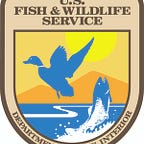Palouse Prairie Remnant Restoration
Bringing Native Plants and Pollinators back to the Palouse, One Step at a Time
What is the Palouse Prairie, you ask? Private landowners in southeast Washington and northern Idaho know their rolling hills of deep fertile soils and colorful grassland meadows as the “Palouse Prairie.”
When Brittany Morlin, biologist for the Idaho Fish and Wildlife Office, was asked what her favorite part of her job is, she responded, “Spending time with the people, like the landowner on Lone Jake Butte.” This remnant of Palouse prairie is home to native bees, butterflies, and other beneficial insects because of the work done to maintain native Palouse Prairie plants. “I loved watching her excitement as she gave me a show-and-tell tour of her property and it became apparent that she is making a difference as a land steward.”
One hundred fifty years ago, the typical vegetation throughout the area consisted of perennial bunchgrasses, such as Idaho fescue and bluebunch wheatgrass, and dozens of different wildflowers blanketed the landscape. These Palouse Prairie plants were replaced by agricultural crops because the soils offered great farming potential. By the 1900, over 90 percent of the Palouse Prairie had been converted to agriculture. Residential development and invasion by weedy plants further threaten these remnants of prairie, reducing their size and making them less connected. This isolates remaining rare wildflowers plant populations and their pollinators from one another.
Thanks to the dedication of a committed landowner, efforts to conserve and restore Palouse Prairie habitat on Lone Jack Butte are helping to preserve a haven for pollinators now and into the future. The high forb component of native Palouse Prairie and the long growing season, deep soils and low elevation of this habitat provides a critical opportunity to increase available breeding and nectar habitat for monarch butterflies as well as other native pollinators. With funding assistance from the Fish and Wildlife Service’s Partners for Fish and Wildlife Program, and in partnership with the Latah Soil and Water Conservation District, the landowner is restoring sections of her Palouse Prairie remnant using ecologically sensitive weed control techniques, followed by seeding with native species. The landowner is also extending prairie habitat by converting five acres of former non-native pasture to native Palouse Prairie plant community, providing a critical pollinator pathway through a fragmented landscape.
“When I learned how little prairie was left, I knew I needed to protect it. And not just for me. If I’m going to own land, I’m going to take care of it, and at that, I don’t even feel like I own the property. I’m just a steward. It’s everyone’s land, and I’m just here to care for it for you, for the animals, for all the birds and bugs and every other living thing.” -Sarah Metcalf, Lone Jack Butte landowner
Through the years, the landowner has spent hours scouting and carefully spot-treating invasive weeds, and seeding the native grasses and forbs. These efforts have paid off and are being protected long-term through a conservation easement with the Palouse Land Trust. While the landowner knows the weed control efforts must go on, they are enjoying the benefits of their hard work, like the sounds of the bumblebees all around!
By: Allyson Turner, Public Affairs Officer for the Idaho Fish and Wildlife Office
